Interview Danielle Austria and Bella Arichea
Images Makie Cruz and Anne Bianca


The story of how you got into drag was pretty interesting. I learned from one of your interviews that the day you auditioned at O Bar was also your first time to see a show.
And it was my first time entering a bar.
Before then, had you already been thinking of doing drag? Can you give us the full story of that evening?
No, I wasn’t. Medyo malaki yung (time) gap between the audition and when I learned about it. Around that time, I was having a quarter life crisis. Nasa Starbucks ako sa Metrowalk with friends to refresh after a birthday celebration karaoke. I don’t know why pero, for some reason, napunta sa akin ang usapan. One of them was working at an investment company, another for a designer, and the other one is still working in real estate. The three of them were very successful. I was the odd one out. I didn’t have a permanent job because I worked in production for the film industry, and that kind of work was fly by night. So kung tapos na yung project, tapos na yung trabaho mo. There’s no permanence. ‘Di ka well-compensated.
Back then, I was also doing woodworking, I was sewing clothes, and I’m interested in performing. Sabi nila: “Saan ka ba talaga lulugar? Ano ba talaga gusto mo?” “I don’t know.” Kaya nga tinatawag na quarter life crisis kasi di ba, if alam mo eh di sana natuhog mo na. Nagkataon, my friend went on Facebook and saw O Bar’s poster looking for drag queens to audition. Sabi ko, “Why not?” Maipapasok ko yung pananahi ko, makeup skills, performing skills most definitely sa drag.
So I prepared. Nag-aral ako mag-makeup for drag. It’s different from when you’re doing regular makeup. Inaabot ako noon ng four hours, three hours, which is not good if you’re going to do it as a career. It’s too long. So I kept on practicing and narrowing it down to one hour. Awa ng Diyos, I still had time to prepare a song, bumili ng sapatos. Isa siyang mahirap na proseso kumbaga.
If you’re a big girl, one of the biggest struggles you’re going to face are shoes. Clothes are not a problem because if you don’t know how to sew, you can always go to secondhand shops. At that time, my only option was Payless at yung sapatos na nakuha ko ay yung pang-guro. Black shoes with two-inch heels. And I felt so powerful, I felt so good at that time pero hindi ko alam na chaka pala siya. Actually, hindi naman siya chaka—hindi lang siya trend at the time.
Sa audition day, wala masyadong kalbaryo. When I went there, the drag queens were rehearsing for Manila Luzon’s homecoming event. (Manila Luzon is a famous Filipino drag queen from RuPaul’s Drag Race.) So all of them were there, they got to see me at my audition. I did ‘Land of Lola’. Kaya pala chine-cheer nila ako kasi piyesa na pala nila yun sa O Bar. It’s a group production. Alam ko siya by heart kasi nga I’m a theater graduate. Nakapasa na ako, I got in and started training.
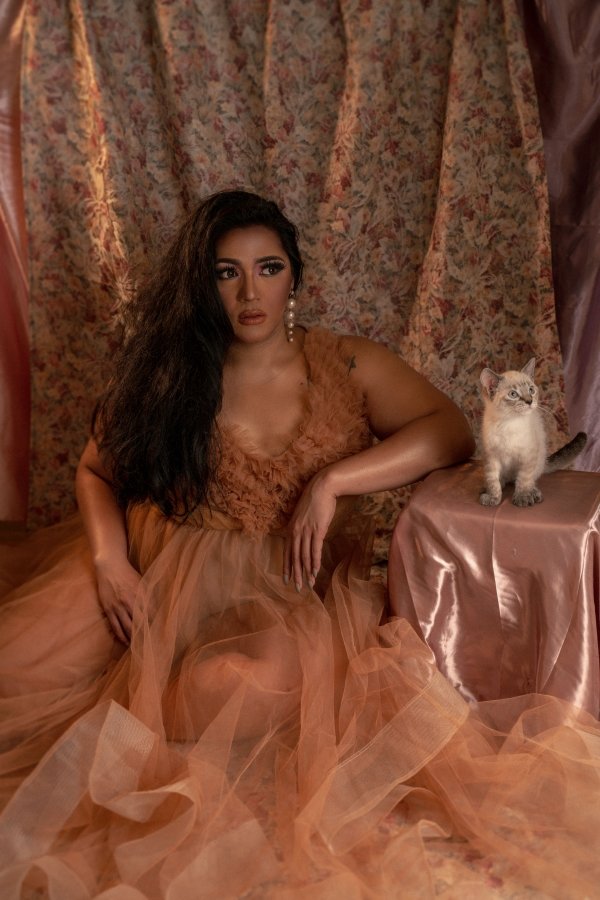

What were your first shows like?
My very first gig, and I’m very fortunate kasi hindi lahat nagagawa ito, was Manila Luzon. That’s big if you’re a baby drag queen. And after that, training lang. Sa bar, kailangan mo muna maging GRO kasi you have to introduce yourself to the customers. Hindi ka basta-basa sasalang ng stage because they would have gone: “Who the fuck are you?” They will not tip you because they don’t know you, even though you’re great. O Bar is such a big bar. You have to know your regulars. And on my second week, pinasalang na nila ako pero hindi on the regular set.
Pang-ilan kang performance at that time?
Last. I was always the last. But on the third week, sinama na nila ako sa regular set. Medyo fortunate ako kasi sa O Bar, ‘pag bago ka, hindi ka bibigyan agad ng solo kasi you might fuck up and that’s not good. I guess, I’m that good [laughs] kasi the drag queen themselves told me na ‘pag baguhan, hindi binibigyan ng solo. Ang boss namin ang nagsabi na, “Pag-solohin niyo yan.” Pero I still struggled kasi alam mo na, isa kang baguhan at hindi nawawala doon na nasa backstage kayo ng labing-limang bakla, iba-iba kayo ng personalities.
I remember that I was so good at choreography, I was part of all the group productions. All of those choreographies ay kabisado na nila for years and months. Eto ako, ni-rehearse ko lang ng hapon at isa pang pagkakataon ng run-through and after that, isho-show ko na siya. I only have two chances to make everything right. ‘Yun ang mahirap ‘pag baguhan ka tapos nag-work ka sa bar. Bilang performer, kailangan mo muna gamayin ang entablado. Every performer knows that one stage is different from another stage. Alam mo yung bawat kanto. ‘Pag binigay mo na ang kaluluwa mo sa entablado na ‘yon, nagiging isa na kayo eh. It’s called spatial awareness.
Do you think your theater background has given you a boost to speed up your adjustment period to the whole world of drag?
That’s true. I totally believe in that. Lahat ng inaral ko sa kolehiyo na-apply ko. Kasi sa pelikula, hindi ko ma-apply agad eh. Tumatakbo ako sa likod ng camera, naka-headset ka, naka-talkback ka. Ang training ko ay mag-perform. Na-deprive ako ng ilang years to perform kaya nung binigyan ako ng pagkakataon sa O Bar, talagang buhos, sobrang buhos.
Were there anything about drag that you found surprising?
Isang culture shock lang talaga sa akin was the tipping culture. You will have to leave your integrity backstage. Sabi nga ng kasama ko, “We are artists, but we are begging.” Kasi iba ang practice dito. Sa ibang bansa kasi, you tip them while they are performing. Here in the Philippines, you tip them too but after, and it’s not every day that you see someone tip while a performance is on. Sa isang banda, maiintindihan mo kasi we are in our element and then bigla mong aabutan, medyo nakakabasag nga naman yun. But what I didn’t like was pagod na pagod ka na, you work so hard for the whole night tapos manghihingi ka pa. That was a culture shock na hindi ako prepared at first.
Oh, and another thing: there are a lot of people in my life that I thought were one way, but I saw them at the bar.
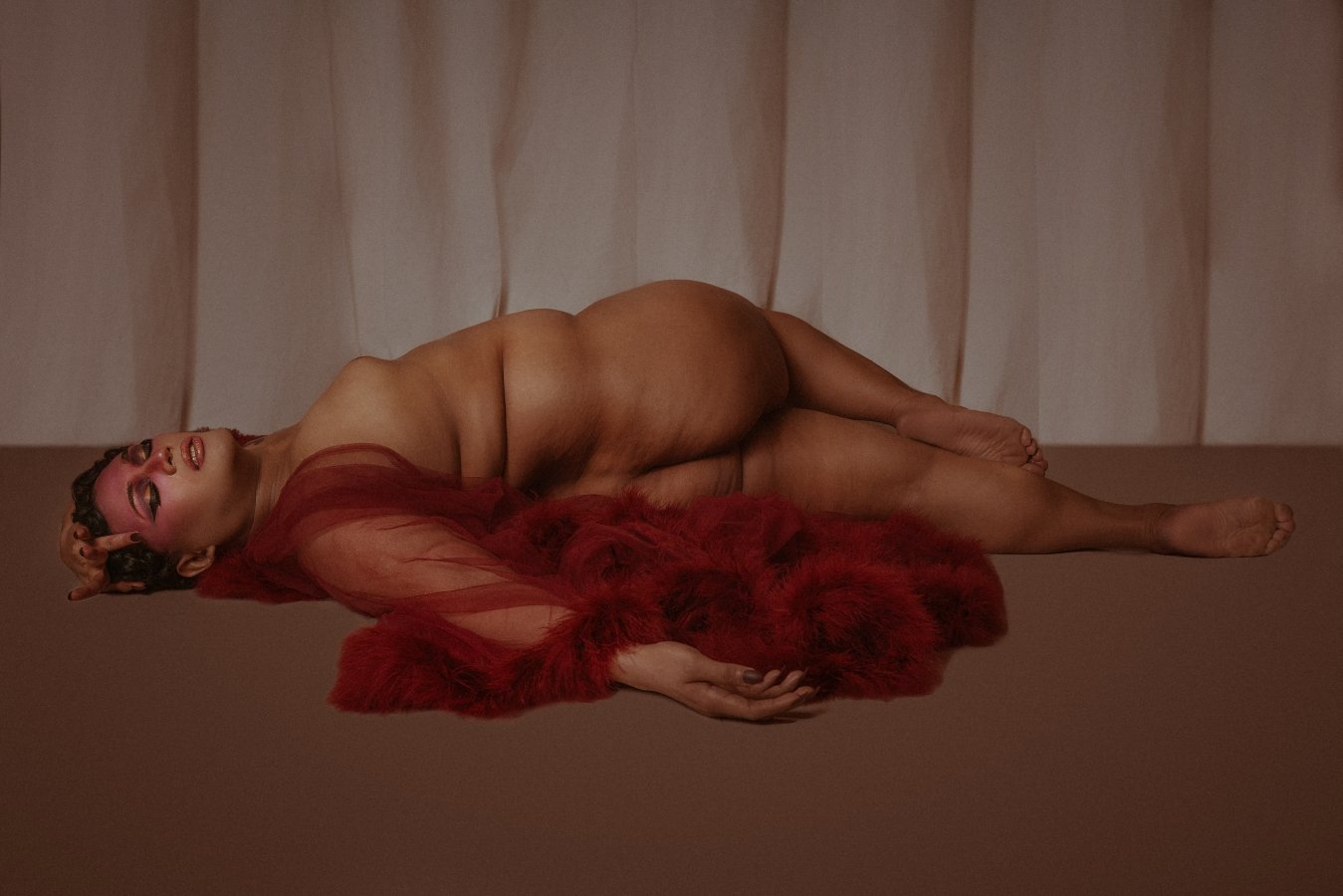

That last part could be a testament to the kind of safe space the bar offers. I’m sure drag queens like you play a big role in that, as people may think: “Oh, here are people who are living loudly and expressing themselves. I can be here. I belong here.”
The good thing about O Bar: people there don’t care if you’re an artist or not. Everyone there is a star. Everyone has a clean slate. They don’t care if you’re an artist or a vlogger. Hindi mo kailangan mag-kubli. Gay men can spot bullshit from a mile away. You have to strip down to your real self. If you put on a facade, ikaw ang mahihirapan kasi doon, everyone is trying to be as real as they can be.
Alam mo ang maganda sa O Bar: family. People go there to find their new family. Sobrang close na ng customers minsan, may specific table na sila. Alam na namin anong araw sila pumupunta.
You’ve been doing drag for how many years now?
Five years, professionally.
What goes into a drag performance?
There are songs that I hear on the radio, habang nasa Grab, nasa mall, and I find it very interesting and then aaralin ko siya. Sa mga ganung pagkakataon kasi, mabilis ako mag-aral ng kanta eh. Mabilis ako magkabisa, yun ang pinagpala ako. May instances din na a song was heard by someone and they immediately thought of me. May mga kanta naman na I look for—gusto ko ng masaya, gusto ko ng malungkot. Maghahanap ka talaga muna ng piyesa.
Aaralin ko siya. I will have to make sure that I know the song by its heart and by its soul. They call me the Lip Sync Assassin, and at first, hindi ko siya tinatanggap kasi I’m just doing my job. I have to know the lyrics, the backstory. Ano yung meaning ng kanta? Ano ang halaga nito sa artist? Ano ang eksena bago niya kantahin ‘to? Dini-dissect ko ang kanta para maramdaman ko. Minsan, pinapanood ko ‘yung performance ng artist, just to see if I can get something from there. ‘Yun ang freedom mo eh when you’re doing someone else’s song—you can copy what they’re doing or you can have your own interpretation.
I always tell my audience who request live, “I will do it as long as I know the song.” I am an artist first. I have to do the song justice. You will tip me. Hindi mo naman pinulot ang pera mo. I’m very grateful for that. So if you’re going to request, I have to know the song.
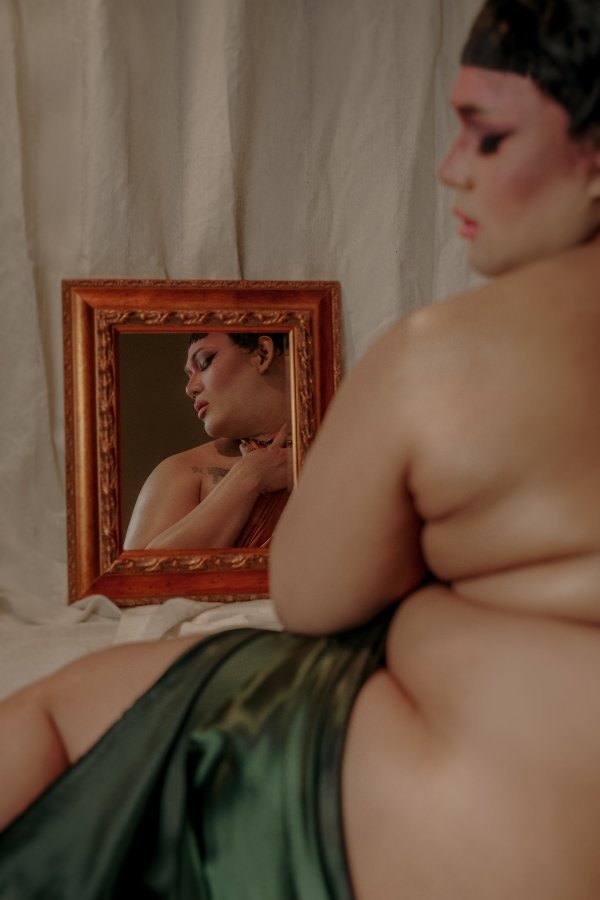

I get that. You have said before that a drag performance is storytelling, and I really feel how much you respect your art with your process and principles.
A lot of people nowadays don’t consider drag an art form. It is an art form. It encompasses a lot of art forms. The art of makeup, the art of clothing, the art of performing, the art of singing, the art of dancing. It encapsulates all of that into one performance. It’s just that a lot of people don’t know what drag is, therefore they don’t see it as an art form.
What do you think are the barriers to that?
Awareness. That’s it. Ano ang nakapaloob sa drag? Sino ang mga drag queens, drag kings? Hindi nila alam, but they feel they can have a say on it. “Ah hindi naman ‘yan art eh. Ito ang art: painting. Ito ang art: singing.” Pero hindi nila alam na ginagawa din namin yun but in other ways.
Are you seeing ways and possibilities right now for local drag to go mainstream?
Conflicted. Yes, kailangan maging mainstream ang drag. But the question is: Is the Philippines ready for a mainstream drag show? ‘Yung mga nakikita mo na drag shows dito, some of the people who make those shows and contests don’t know drag. Honestly, wala pa akong nakikitang drag show right now in the Philippines na nilikha kasi gusto nila talaga bigyan ng pagkakataon ang mga drag queens. Yes, pinapakita nila sa television pero they have their own reasons behind that. Do they really want the masses to understand what drag is? Or do they just want an idea for another show?
I hope na itong sa bagong reality show ni Manila Luzon (‘Drag Den Philippines’)*, Manila is the one who really wanted to do it or isa siya sa mga nag-spearhead noon kasi if ever, ‘yun yung magiging first for me. There are a lot of other contests online, but they just want to exploit us.
*Drag Race Philippines is a separate competition, announced earlier by RuPaul as a direct franchise of his hit show.
Kasi trend?
Yes. That’s where I’m going. Oh, let’s do a drag show kasi trending siya ngayon. But do you really know what drag is? May kilala ka bang sampung drag queens sa Pilipinas?
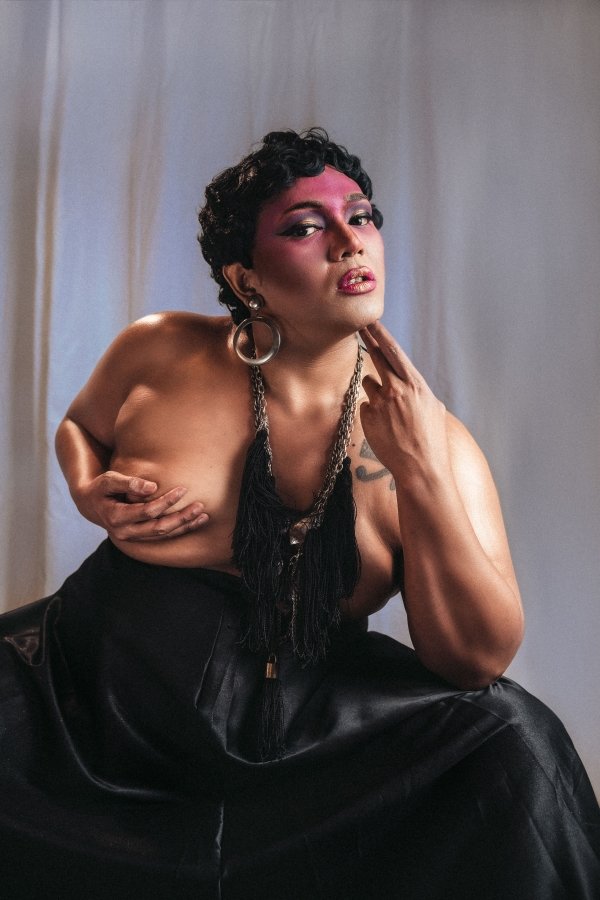

Let’s talk about beauty. What was your first memory of thinking something was beautiful?
Oh, my earliest memory. I’ve always really loved fashion. Ang frustration ko ay gusto ko maging maganda, maging model. I collected Preview magazines when I was in high school. Back then, sila Sasha Pivovarova and Jessica Stam ang supermodels that I really looked up to. No matter what they looked like, they were beautiful.
I love weird things, so I love weird makeup. At a very young age, alam ko na agad na ang maganda is not limited to someone like a beauty queen. Beauty is someone who is also weird. Beauty is everywhere.
It seems to me that you’ve predetermined your concept of beauty early on, that it’s something you define for yourself rather than subscribe to standards. Has this been challenged as you grew up?
No. Rock solid. I’m super duper happy that being a drag queen gave me the opportunity to be a model, to accept my body. It took me a lot of years to accept my body. I can lose weight, but what matters is the acceptance that no matter how you look like right now in front of the mirror, you are beautiful.
In one of your captions on Instagram, you said: “The world says beauty is changing, fuck that…” What was the thought running through your mind at the time?
That is a line from Jessie J’s ‘Queen’. I fell in love with it as I’m studying it. We humans are programmed to have specific judgment or ideas on beauty. Beauty is changing, but we’re still programmed to look in specific lenses. Noong 90s, maganda ‘pag payat o size zero, mapanga, walang boobs, matangkad. But then along came Kate Moss na 5’7”, nagbago ang standard of beauty pero nandoon pa rin yung payat, size 0, walang boobs. Pumasok si Tyra Banks, nagkalaman siya, binigyan siya ng Sports Illustrated ng cover, nagbago na naman ang standards of beauty.
Hanggang ngayon, mayroon na tayong Lizzo. She doesn’t care. She will wear whatever she wants. She don’t give a damn if her boobs are low.
When one says maganda, usually may switch ang utak natin to imagine a certain type of face. And for most people, it’s really hard to live up to.
Kaya ako wala akong ibang standard of beauty. I made myself the standard of my beauty. Payat, mataba, may bibil, I don’t care. Kasi lumaki ako na ganoon at hindi yun magbabago. Kahit katiting, ayoko pumuti. If this is who I am, then this is who I am.
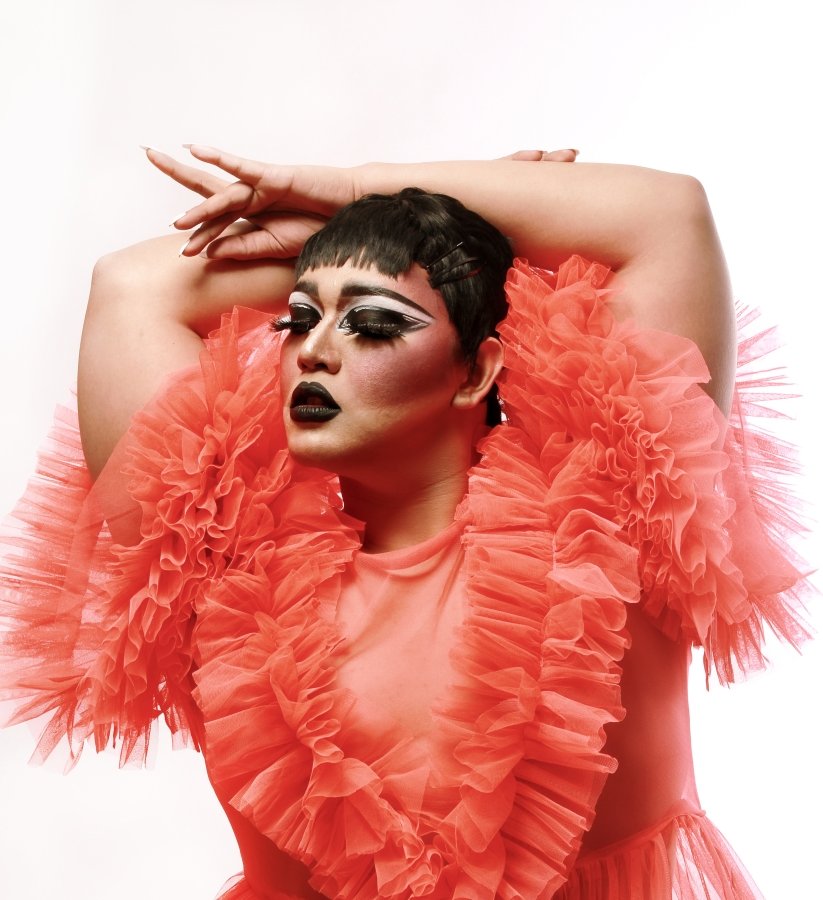

If you were to steer the conversations of beauty in the context of drag, where would you like to take it?
Huwag niyong i-base yung standard of beauty niyo sa Western drag. They have better stuff, better materials. We don’t, here in the Philippines. ‘Wag niyo kami i-compare doon. Ang daming umusbong na new fans ng drag na galing sa RuPaul’s Drag Race. They don’t know na yung mga looks sa RuPaul’s Drag Race ay filtered. ‘Yung mga producers, namili na ‘yun ng looks na papasa sa television. May standards din sila, award-winning na sila. Here, we try our best to look good but sometimes, it’s not enough. Wag niyo kami ikumpara. May sarili silang mundo.
Kung sa tingin mo, itong drag ko na pinaghirapan ko ay di kasing-ganda ng napanood mo sa Drag Race ay mali ka na ng konsepto ng drag. At the end of the day, it’s the performance that you’re going to see. The look is there, but it’s not the bottom line. Ang focal point ng drag ay always the performance. What’s the use of looking good if you will not be remembered by your performance? I’d rather be good with performing than look good on stage. Mas magandang matandaan ka ng tao kasi magaling ka mag-perform.
What should other creatives know about drag queens?
That is also a process. It’s hard work. We don’t always look glamorous. We also struggle. We are struggling artists; we just hide it behind our beautiful faces and performances. Pare-pareho lang tayong may proseso, kailangan lagyan ng effort. Maganda lang talaga kami [laughs]. When people tell us how we look good, it’s a sweet validation because we work hard on it.
It’s not easy. At some point, it can be lucrative. Most of the time, it’s not. You need passion. It’s a 12-hour work day each day at O Bar. Gigising ka para mag-prepare for work, tapos uuwi ka lang para matulog. Mahirap siya.
How did the work shift in the pandemic?
Mahirap ngayon ang pagiging drag queen. I wanted to change careers, honestly, but performing is my life. I am an artist before I am a drag queen. Mamamatay ang kaluluwa ko if gumawa ako ng office work.
Noong bukas ang mga bars, if they don’t like your performance, people will just turn their heads against you. But they’re still there. Ngayon kasi virtual; if someone doesn’t like your performance o nabagot na sila sa’yo, they can just easily exit your livestream and scroll through their feed. It’s so hard [to keep an audience]. Bago mag-pandemic, kung mag-perform ka it’s for yourself and magta-transcend na lang yun sa tao kaya ka nila ma-appreciate, pero now you are performing for them. You’re trying to please them, so they could tip you, wire you money. Which is very difficult. Nakakalungkot kasi sa bar nga, nanlilimos na nga kami. Mas lalo pa ngayon. Naging issue na ‘to. May nagsabi, “Ano ba ang ginagawa ninyo, parang online limos.” And that is not our worth.
How do you see the experience changing post-pandemic?
Most definitely, may magbabago sa akin. I didn’t put as much effort into how I look onstage pero right now, nasanay ako sa virtual na what people will see is what they will enjoy. Most definitely, my looks will be elevated. Just a fun fact: mas marami akong napatahi ngayon kesa sa buong career ko as as drag queen pre-pandemic. Looks are vital. Natuto ako mag-set ng wig kasi gusto ko pai-elevate look ko. I’m known to use my natural hair or short wigs, but right now I’m trying to wear longer wigs again.
When it comes to platforms, siyempre hindi namin pwede iwanan ang bumuhay samin during the pandemic. Kumikita ka doon eh, bakit mo iiwanan? It’s not gonna be every day, but I won’t leave Facebook and Kumu. Nakabuo ka na rin ng fanbase doon eh. Gusto nila malaman anong ginagawa mo.
If our readers want to take their first steps understanding drag, how should they start?
Watch a performance without judgment first. If you have questions, voice it out. We will explain. Watch more, and you will understand eventually what the craft is.
And where can they see performances here in the Philippines?
Right now, there are three major live streaming platforms: Kumu, Bigo and Blued. But most of us you will see on Kumu and Facebook. If you want to watch drag shows, just follow a drag queen and everything will fall into place. Search for a drag queen tapos susunod-sunod na ‘yun.
For baby drag queens, sometimes they ask me for advice, too, on starting out. I say, alamin niyo muna ano ang drag. Ano ang history? Other queens say, “Just start.” Pero kung magu-umpisa ka lang basta-basta, you’ll just be another face in the crowd. If you know what you’re doing, you will achieve more. ●
Find our queen, Turing Quinto, on Instagram @turingquinto and see her performances on Kumu.

